
Anders Erik Vilhelm Jarvik was a Swedish paleontologist who worked extensively on the sarcopterygian fish Eusthenopteron. In a career that spanned some 60 years, Jarvik produced some of the most detailed anatomical work on this fish, making it arguably the best known fossil vertebrate.

Dunkleosteus is an extinct genus of large arthrodire ("jointed-neck") fish that existed during the Late Devonian period, about 382–358 million years ago. It was a pelagic fish inhabiting open waters, and one of the first apex predators of any ecosystem.

Ventastega is an extinct genus of stem tetrapod that lived during the Upper Fammenian of the Late Devonian, approximately 372.2 to 358.9 million years ago. Only one species is known that belongs in the genus, Ventastega curonica, which was described in 1996 after fossils were discovered in 1933 and mistakenly associated with a fish called Polyplocodus wenjukovi. ‘Curonica’ in the species name refers to Curonia, the Latin name for Kurzeme, a region in western Latvia. Ventastega curonica was discovered in two localities in Latvia, and was the first stem tetrapod described in Latvia along with being only the 4th Devonian tetrapodomorph known at the time of description. Based on the morphology of both cranial and post-cranial elements discovered, Ventastega is more primitive than other Devonian tetrapodomorphs including Acanthostega and Ichthyostega, and helps further understanding of the fish-tetrapod transition.
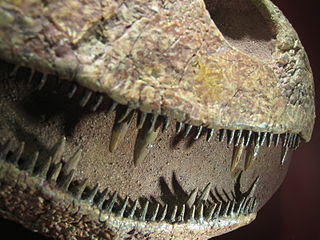
Tristichopterids (Tristichopteridae) were a diverse and successful group of fish-like tetrapodomorphs living throughout the Middle and Late Devonian. They first appeared in the Eifelian stage of the Middle Devonian. Within the group sizes ranged from a few tens of centimeters (Tristichopterus) to several meters.

Rhizodus is an extinct genus of basal, finned tetrapodomorphs. It belonged to Rhizodontida, one of the earliest-diverging tetrapodomorph clades. Two valid species have been described, both of which lived during the Early Carboniferous epoch. The type species R. hibberti is known from the Viséan stage of the United Kingdom, whereas the species R. serpukhovensis is from the Serpukhovian of Russia. Some fossils referred to the genus Rhizodus have also been found in North America.
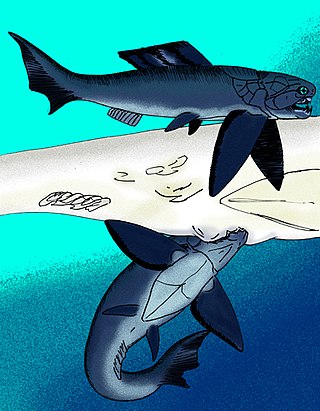
Dinichthys is an extinct monospecific genus of large marine arthrodire placoderm from the Late Devonian measuring around 3 metres (9.8 ft) long. Fossils were recovered from the Ohio Shale Formation along the Olentangy River in Delaware County, Ohio.

Eusthenodon is an extinct genus of tristichopterid tetrapodomorphs from the Late Devonian period, ranging between 383 and 359 million years ago. They are well known for being a cosmopolitan genus with remains being recovered from East Greenland, Australia, Central Russia, South Africa, Pennsylvania, and Belgium. Compared to the other closely related genera of the Tristichopteridae clade, Eusthenodon was one of the largest lobe-finned fishes and among the most derived tristichopterids alongside its close relatives Cabonnichthys and Mandageria.

Tristichopterus, with a maximum length of sixty centimetres, is the smallest genus in the family of prehistoric lobe-finned fish, Tristichopteridae that was believed to have originated in the north and dispersed throughout the course of the Upper Devonian into Gondwana. Tristichopterus currently has only one named species, first described by Egerton in 1861. The Tristichopterus node is thought to have originated during the Givetian part of the Devonian. Tristichopterus was thought by Egerton to be unique for its time period as a fish with ossified vertebral centers, breaking the persistent notochord rule of most Devonian fish but this was later reinspected and shown to be only partial ossification by Dr. R. H. Traquair. Tristichopterus alatus closely resembles Eusthenopteron and this sparked some debate after its discovery as to whether it was a separate taxon.
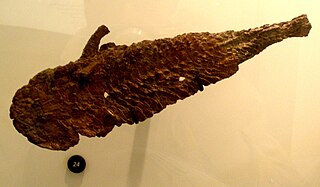
Megalichthyidae is an extinct family of tetrapodomorphs which lived from the Middle–Late Devonian to the Early Permian. They are known primarily from freshwater deposits, mostly in the Northern Hemisphere, but one genus (Cladarosymblema) is known from Australia, and the possible megalichthyid Mahalalepis is from Antarctica.

Osteolepididae is a family of primitive, fish-like tetrapodomorphs that lived during the Devonian period. The family is generally thought to be paraphyletic, with the traits that characterise the family being widely distributed among basal tetrapodomorphs and other osteichthyans. Some of the genera historically placed in Osteolepididae have more recently been assigned to the family Megalichthyidae, which appears to be a monophyletic group.
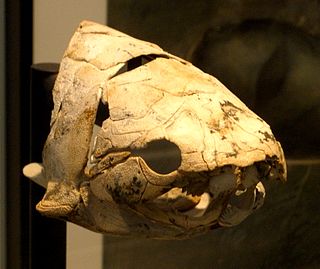
Eastmanosteus is a fossil genus of dunkleosteid placoderms. It was closely related to the giant Dunkleosteus, but differed from that genus in size, in possessing a distinctive tuberculated bone ornament, a differently shaped nuchal plate and a more zig-zagging course of the sutures of the skull roof.
Cryptolepis is an extinct genus of prehistoric sarcopterygian or lobe-finned fish.
Tarachomylax is an extinct genus of prehistoric sarcopterygians or lobe-finned fish.

Plourdosteus is an extinct genus of placoderm arthrodire which was relatively widespread in Euramerica during the Givetian to Frasnian ages of the Devonian. It was a small placoderm, with P. canadensis specimen MNHM 2-177 measuring 37.5 cm (14.8 in) long.

The skull roof or the roofing bones of the skull are a set of bones covering the brain, eyes and nostrils in bony fishes and all land-living vertebrates. The bones are derived from dermal bone and are part of the dermatocranium.
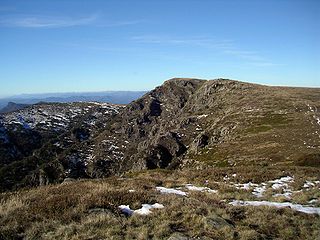
Marsdenichthys is an extinct genus of Devonian tetrapodomorph. Fossils have been found from Mount Howitt in Victoria, Australia from strata that are Givetian-Frasnian in age. Mount Howitt is an important site that has been the source of many tetrapodomorph fossils, including Beelarongia and Howittichthys, both of which were first described from the locality.
Acondylacanthus is an extinct genus of ctenacanthiform from the Paleozoic era. The type species is A.gracilis. Most species are known from the Carboniferous of America and the British isles. A. jaekeli is known from the upper Frasnian of Germany and the Upper Famennian of Russia. This genus is based entirely upon isolated dorsal fin spines, and thus may later be found synonymous with tooth-based genera. Many species have been ascribed to this genus, though there has been some confusion with Ctenachanthus. This genus is in need of review and research.
Compagopiscis is an extinct genus of placoderm known from the Gogo Formation. It lived in the Upper Devonian of Western Australia. The genus is monotypic, with its only species being Compagopiscis croucheri.




















